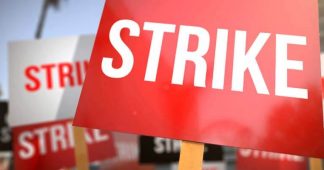2021 marked a historic year in labor organizing for workers in the US, with tens of thousands of workers in partaking in union votes and strike actions
by Monica Cruz*
December 27, 2021
2021 was a historic year for labor in the US. An eruption of strikes, major contract wins, and workers quitting low-wage jobs in unprecedented numbers all signaled that workers en masse are ready to reclaim their power. Workers organized union drives across nearly every industry, pushed for union reforms, and elected new union leadership, speaking volumes to their desire for a more democratic workplace.
For many workers, the pandemic revealed the cruelty of capitalism. Mainstream media and politicians campaigned for a return to business as usual during this second year of COVID. In particular, workers, called “essential” and “heroes” during the pandemic, were expected to continue sacrificing the most while receiving the least in pay and benefits. At the same time, the world’s biggest corporations made record-breaking profits and the richest individuals saw their wealth multiply.
Throughout the year, right-wing pundits and lawmakers cried wolf about a “worker shortage,” using this to justify cutting off pandemic unemployment benefits. In reality, the end of the year saw a near record number of people quitting their jobs. What’s clear is that workers are no longer willing to settle for low pay and terrible conditions.
As Kooper Caraway, President of the South Dakota Federation of Labor, AFL-CIO, told BreakThrough News back in June, “I think that it’s not necessarily that workers are gaining more leverage, but that workers are recognizing the leverage they already have. And choosing to exercise it.”
Workers fight to unionize
In the most high-profile win, two Starbucks stores in Buffalo, New York became the first Starbucks locations in the country to vote to unionize, despite an egregious anti-union campaign. Union drives are underway in several more states, with an election filing just recently announced in Tennessee.
After filing for a union back in May, 17,000 higher education workers at the University of California voted to strike for recognition. Two weeks later, the University agreed. The new union, Student Researchers United, is the largest new union formed in the country in recent decades.
2021 also marked a record-breaking year for journalists getting organized across the country. The NewsGuild, the largest union representing journalists, broke its annual organizing record with 1,542 journalists across 26 workplaces joining the union.
After decades of decline, only 10% of workers in the US belong to a union. According to unionelections.org, there have been 1,314 private sector union elections filed and 907 union elections held in 2021. A new unit was certified in 571 of those elections. At the same time, approval of labor unions is at 68%, the highest point since 1965.
Year of the strike
Cornell University’s ILR School Strike Tracker reported a total of 363 strikes across the country (as of December 27).
The key characteristic about this year of labor action was not necessarily the quantity, but the quality, or rather the length and breadth of the strike actions in 2021. In major industries such as food service, education, industrial production, food production, and mining, tens of thousands of workers embarked on industrial action. Prestigious educational institutions saw some of the largest strikes. The largest ongoing strike in the country is taking place at Columbia University in New York City where 3,000 graduate student workers are on their ninth week of their strike to demand fair pay and healthcare benefits. A similar strike of graduate student workers took place at Harvard back in October.
Another critical aspect of the strikes were the similar conditions which pushed the workers onto the picket line. Workers at John Deere, Kellogg, and Frito Lay all went on strike—and won their demands—over proposed extensions to two-tier pay and benefit systems, an insidious tactic to divide workers and give newer workers less.
Workers in fast food and retail organized walk outs and strikes over long hours, low pay and measly benefits. From McDonald’s and Wendy’s, to Walmart and Family Dollar, thousands of workers in the industries that provide essentials to millions everyday demanded better and won.
Workers at United Metro Energy in Brooklyn, New York have been on strike since April. Despite several retaliatory firings, the workers have held out demanding better pay, expanded healthcare coverage, and a grievance process for disciplinary actions and firings.
In Alabama, more than 1,100 miners at the Warrior Met Coal Mines have been on strike for over eight months demanding an end to pay cuts, more time off and affordable health insurance. The workers have held strong despite multiple vehicular attacks on the picket lines and the company’s attempts to stop their picket. The workers, members of the United Mine Workers of America, even traveled from Alabama to New York City to protest at BlackRock, Warrior Met’s biggest investor.
At their picket back in July, striking miner Dedrick Garner told Monica Cruz, “Whatever it takes, we’re gonna be one day longer, one day stronger.”
Then there were the strikes that didn’t come to be, two of which scored major wins for healthcare workers, who have risked their lives day in and day out to care for the millions impacted by the pandemic.
Back in July, over 1,500 nursing home workers in Pennsylvania won historic pay raises less than 24 hours before the one-day strike was set to take place. These raises mean more than pay. For an industry whose low pay has played a huge role in it’s understaffing crisis, better pay is equal to a more safe and stable work environment for nursing home and home care workers.
The largest healthcare strike in decades was narrowly averted at Kaiser Permanente healthcare providers and hospitals. 35,000 workers who were set to strike in November won a four-year agreement that includes pay raises and measures to address understaffing. The company withdrew its proposal for a two-tier pay system that would pay new hires a third less than current workers.
In the days following the tentative contract agreement, Jeanne Narmore, a phlebotomist who’s been working at Kaiser for 25 years, told Monica Cruz, “The past two nights have been really rough, stressful, and sleepless for us.” She continued, “I am looking forward to seeing my patients and seeing the improvements being made for patient care!”
Workers take on Amazon
Without a doubt, Amazon was this year’s biggest labor boogeyman. Throughout the pandemic, the trillion-dollar company has become synonymous with unfair labor practices and inhumane working conditions, all while making record-breaking profits. With nearly one million workers and counting, Amazon is on track to become the largest employer in the US. In 2021, the megacorporation faced a level of worker organizing and resistance that it’s never seen before.
In one of the biggest labor stories of the year, workers at an Amazon warehouse in Bessemer, Alabama struggled through months of captive-audience meetings, threats, and surveillance to hold an election with the National Labor Relations Board (NLRB) on whether to form a union with the Retail, Wholesale, and Department Store Workers Union (RWDSU). Amazon trampled on labor law to nix any chance of a union win and succeeded in April. Some saw this defeat as an indicator that unionizing the world’s second largest retailer was impossible. But workers have continued to push forward union drives and organizing efforts from Bessemer to New York and Chicago.
Over the summer, the NLRB upheld the RWDSU’s charge that Amazon illegally intervened in the election. And earlier this month, a regional director formally granted workers a second shot at voting, which will happen sometime next year. Another victory at the NLRB arrived on December 23rd, when Amazon settled with the board to allow its warehouse employees to unionize more easily.
Amazon said it will email its one million plus past and present warehouse workers, notifying them of their rights and will give them “greater flexibility” to organize. Under the agreement, the NLRB will be more easily able to sue Amazon if it finds that the company has violated the terms.
In another memorable update, one of the largest unions in the country threw down the gauntlet in the fight to unionize Amazon. The 1.4 million member-strong International Brotherhood of Teamsters voted to approve a resolution calling for an all-encompassing campaign to mobilize and organize Amazon workers across the US. The Teamsters, which is the largest union representing workers in the shipping and logistics industries, has fought for decades to set better standards on pay, benefits and workplace protections for workers like those at Amazon.
Randy Korgan, the Teamsters’ National Director for Amazon, told Monica Cruz in July, “We want to be clear about one thing: we’re going to partner up with everybody. The reality is that Amazon presents a challenge in a way that, I think, shows everybody should be working together.”
In the spirit of working together, on Black Friday, Amazon workers in over 20 countries coordinated the biggest day of strikes and actions against the company ever. The Make Amazon Pay coalition, made up of 70 unions, environmentalist groups, non-profit watchdogs and grassroots organizations, planned the actions spanning four continents.
Right before Christmas, workers staged a walk out at two Chicago delivery stations to demand better pay and working conditions.
Big wins for more democratic and progressive unions
Unionized workers fought to make their unions a better representative of rank and file worker power in 2021. After a decades-long push, the United Autoworkers (UAW) “one member, one vote” referendum passed on December 1st, establishing a direct voting system for the union’s leadership. The effort to get this reform on the voting block heated up in the past couple years, when top union officials were prosecuted on a range of corruption charges. The details on how the new election process will work are expected to be a major point of contention at the UAW Constitutional Convention, set for June 2022.
For the first time in a quarter century, a slate backed by Teamsters for a Democratic Union won in a landslide to lead the Teamsters. The Teamsters United coalition leaders have pledged to lead militant contract campaigns and end the two-tier system at UPS. Incoming president Sean O’Brien has stated his intentions to raise the starting pay of part-timers at UPS from $14 to $20 an hour and strike if necessary. This platform is a major improvement from that of past leadership, which overruled a strike authorization as well as a membership vote against a proposed two-tier pay system. The Teamsters is the largest private sector union in the country.
In news that didn’t make national headlines, public school teachers in San Francisco voted in the largest turnout in the union’s recent history of internal elections. Within the United Educators of San Francisco, the Organizing for Union Power slate won every seat it ran a candidate for. The slate ran on a progressive four pillar program, which included developing new leaders, empowering the membership, building coalitions and community power, and fighting for fully-funded and equitable schools.
Monica Cruz spoke with the then-newly elected President Cassondra Curiel, who emphasized, “It’s really about building out a program for our union structure that will accurately represent the members in a way that members can see themselves in some part of it.” She continued, “The work that I do doesn’t belong to me…the work belongs to the organization and the organization belongs to the workers.”
What’s next?
Facing year 3 of the coronavirus pandemic, historic income inequality and decades of stagnant wages, this labor revival is guaranteed to escalate in 2022. A data analysis by Bloomberg Law found that 185 large union contracts, representing more than 1.3 million workers, are set to expire in the new year. On top of the expirations are first contracts that have yet to be ratified, particularly for recently-unionized workers in media outlets and museums across the country. It’s safe to say that the dire material conditions facing workers in the US have awoken the sleeping giant of a militant labor movement and 2021 has proven that the workers united are not ready to be defeated.
* Monica Cruz is a reporter with US-based media outlet Breakthrough News.
Published at peoplesdispatch.org
We remind our readers that publication of articles on our site does not mean that we agree with what is written. Our policy is to publish anything which we consider of interest, so as to assist our readers in forming their opinions. Sometimes we even publish articles with which we totally disagree, since we believe it is important for our readers to be informed on as wide a spectrum of views as possible.











